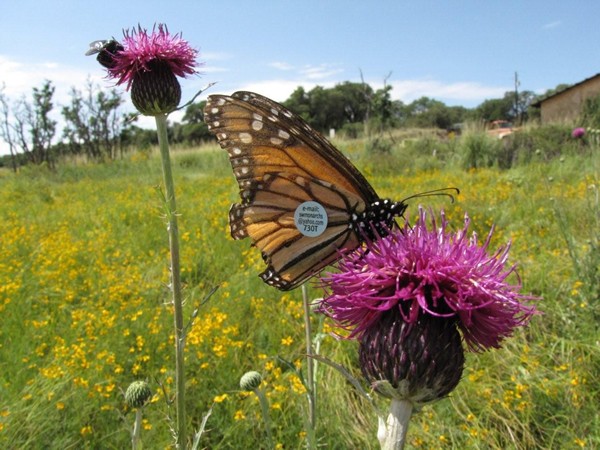Letter From Gail Morris: Western Monarch Fall 2022 Report #4
Published: 10/25/2022
Dear Western Monarch Friends,
Monarchs continue to arrive at the California overwintering sites while many are still reported in route. Monarch sightings this week were mainly in the southern tier of the West in Utah, Arizona, New Mexico, Nevada and California. Monarchs were reported in the mountain passes of California for the first time this season. As cooler weather sets in the region monarchs will hurry on their way. Meanwhile, breeding monarchs were still seen laying eggs in the southern California region as well. Be sure to see the higher density of monarch sightings this week on the Journey North map.
Pacific Grove Update
Exciting news from Stephanie Turcotte at Pacific Grove, California! Last week Stephanie reported that monarchs had not yet arrived at this important overwintering site but this week there is hopeful news.
"I am happy to report and share that the PG monarch numbers are great! Last year at this time we had a little over 2,500, almost to the day (10/20). We counted for 2 hours this morning and kept finding more spread throughout the PG habitat on Eucalyptus, Monterey Pines, and Monterey Cypress. They were located on 28 different trees on the southern, western and eastern ends of the grove as well as in the interior of the sanctuary."
"The final total for this morning is: 3,823."
"The varied weather with heavy marine layer on some days and sudden sunny, warm days on others had us wondering what the actual numbers would be. We were pleasantly surprised they were so high! Hopefully more will come as the season progresses."
Be sure to see the photos Stephanie sent along. “The photos are from private yard where the monarchs were heavily nectaring on those warm days. It’s a species of bottle brush (Melaleuca).
Natural Bridge State Park and Lighthouse Fields Update
Diana Magor shares her monitoring reports at these two important sights in Santa Cruz, California.
On 10/14/2022 Natural Bridges, Santa Cruz:
“The Natural Bridges count was about 1,000 today, 10/14/22, all on Eucalyptus and all up fairly high. 2 large, tight clusters and 7 smaller ones, mostly nearby. A few flyers in the afternoon, but cool (below 60°) with low clouds almost all day.”
Lighthouse Field, Santa Cruz:
“The count (200) at LF today, 10/14/22, was down a bit from last Sun (285). One of the clusters which was at over 100 was down to 7, but the other 2 loose clusters have been in the same location for at least 3 weeks (East side of the sanctuary on small blue gum Eucalyptus). Same cool cloudy conditions.”
“No new eggs or larvae noted in my garden in the last week.”
But this week the monarch numbers were higher. “I finally got photos of the many clusters at Nat Br, and come up with a count of 2,364. I did add in a 10% error to some of the photos of clusters I could not see the backs of but was pretty sure there were more back there. That may be a bit conservative. I would not be surprised if someone came up with 2,500 or even more.
“At Lighthouse Field, I counted 615, so the numbers are up at both sites.” A Great Horned owl appeared at Natural Bridges State Park on 10/22 and sat with the monarchs! (See Diana’s photo!)
“It was cold this am (56°F at 9:15) but the sun was warm and at LF the monarchs on the East side had already started to fly about and switch perch sites. In the shady area near the observation marker, where there were almost twice as many as on the warm E side, they were completely motionless. 1 cluster was forming on an eastern branch of a Cypress near the loose eastern clusters.”
This week Diana also found a 4th instar caterpillar in her garden!
Thank You!
A special Thank You to Stephanie Turcotte and Diana Magor for their reports and photos and Robert Pacelli for his photos at Pacific Grove. We will be waiting to see how the monarch numbers grow in November as the annual Thanksgiving Count grows near.
Send in your reports!
Keep your eyes to the sky looking for monarchs as monarchs reach the final stages of their fall journey. If you are out this week and see monarchs of any life stage, be sure to report them to Journey North—whether they are adults or eggs or larvae. Provide as much information as you can such as weather conditions (it’s okay to estimate). Your detailed description of what you see can include, but is not limited to, the monarch’s gender and activity and, if known, the type of flowers if they are nectaring.
Gail Morris is the Coordinator of the Southwest Monarch Study (www.swmonarchs.org), a Monarch Watch Conservation Specialist, and the Vice President of the Monarch Butterfly Fund, the Central Arizona Butterfly Association and the Western Monarch Advocates. The Western Monarch Population News is based on comments provided to Gail Morris. We hope to increase the number of sightings and therefore photos and comments entered into Journey North. We rely on the volunteers who communicate regularly with Gail and who agree to participate in our effort to increase awareness of the population of western Monarchs. You can reach her at gail@swmonarchs.org
10/25/2022 High in the Trees

10/25/2022 Small Cluster

10/25/2022 Heavily Nectaring

10/25/2022 Numbers Growing

10/25/2022 Great Horned Owl Near Monarchs

10/25/2022 4th Instar Larva

